BM414 - Business Decision Making: Accounting, Finance & Tesco Plc
VerifiedAdded on 2023/06/10
|13
|3721
|161
Report
AI Summary
This report explores the critical role of accounting and finance in business decision-making, particularly within the context of Tesco Plc. It details how accounting functions, such as maintaining financial records, monitoring transactions, and aiding in budget preparation, contribute to achieving business objectives and meeting legal requirements. The report also discusses the functions of finance, including resource allocation, establishing financial objectives, and managing payables and receivables. Furthermore, the report includes a financial ratio analysis of Alpha Ltd. using data from 2017 and 2018, interpreting changes in key metrics like return on capital employed, net profit margin, current ratio, debtors' collection period, and creditors' payment period. This analysis identifies potential reasons and causes for observed changes in the company's financial performance over the two-year period.
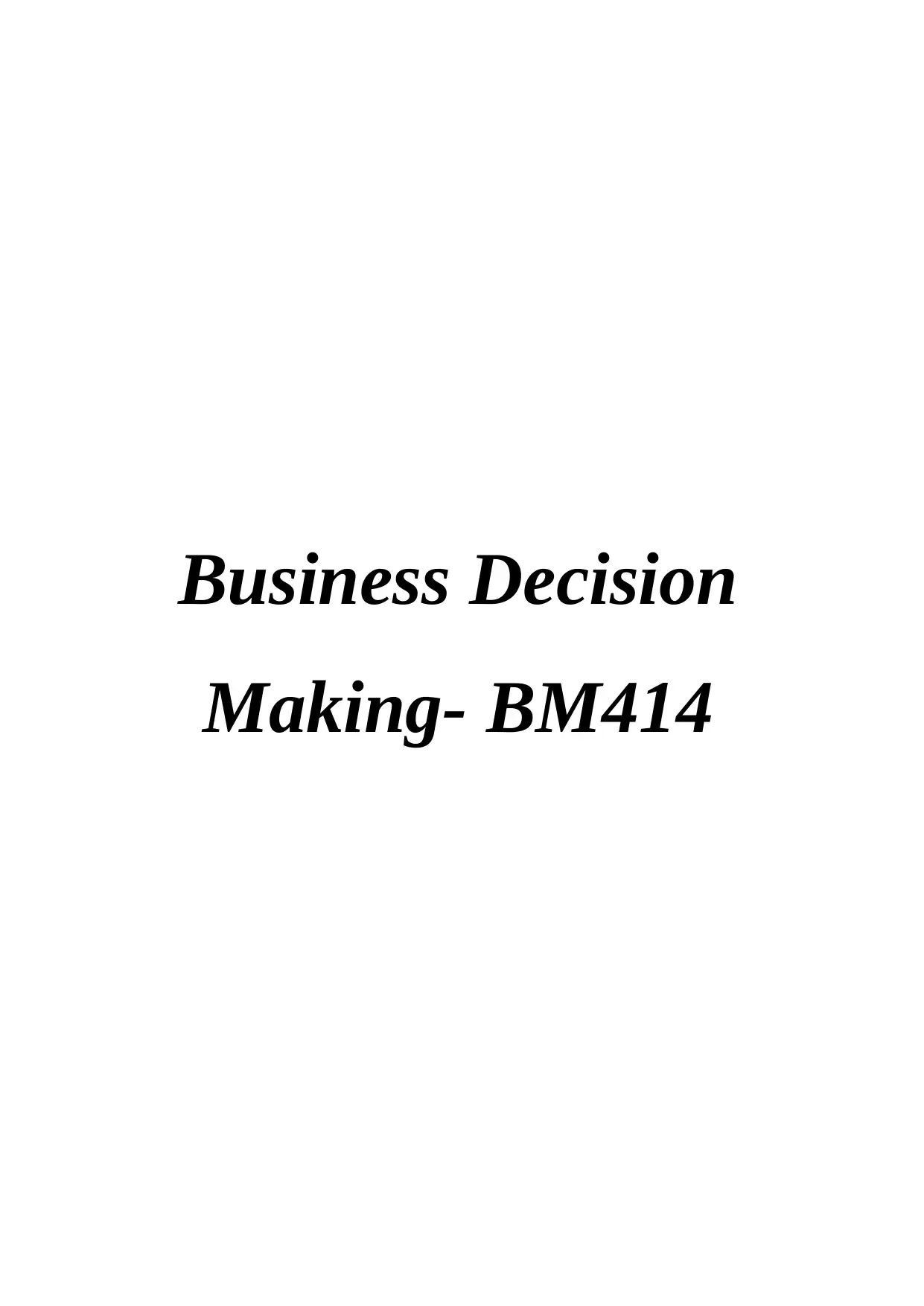
Business Decision
Making- BM414
Making- BM414
Paraphrase This Document
Need a fresh take? Get an instant paraphrase of this document with our AI Paraphraser
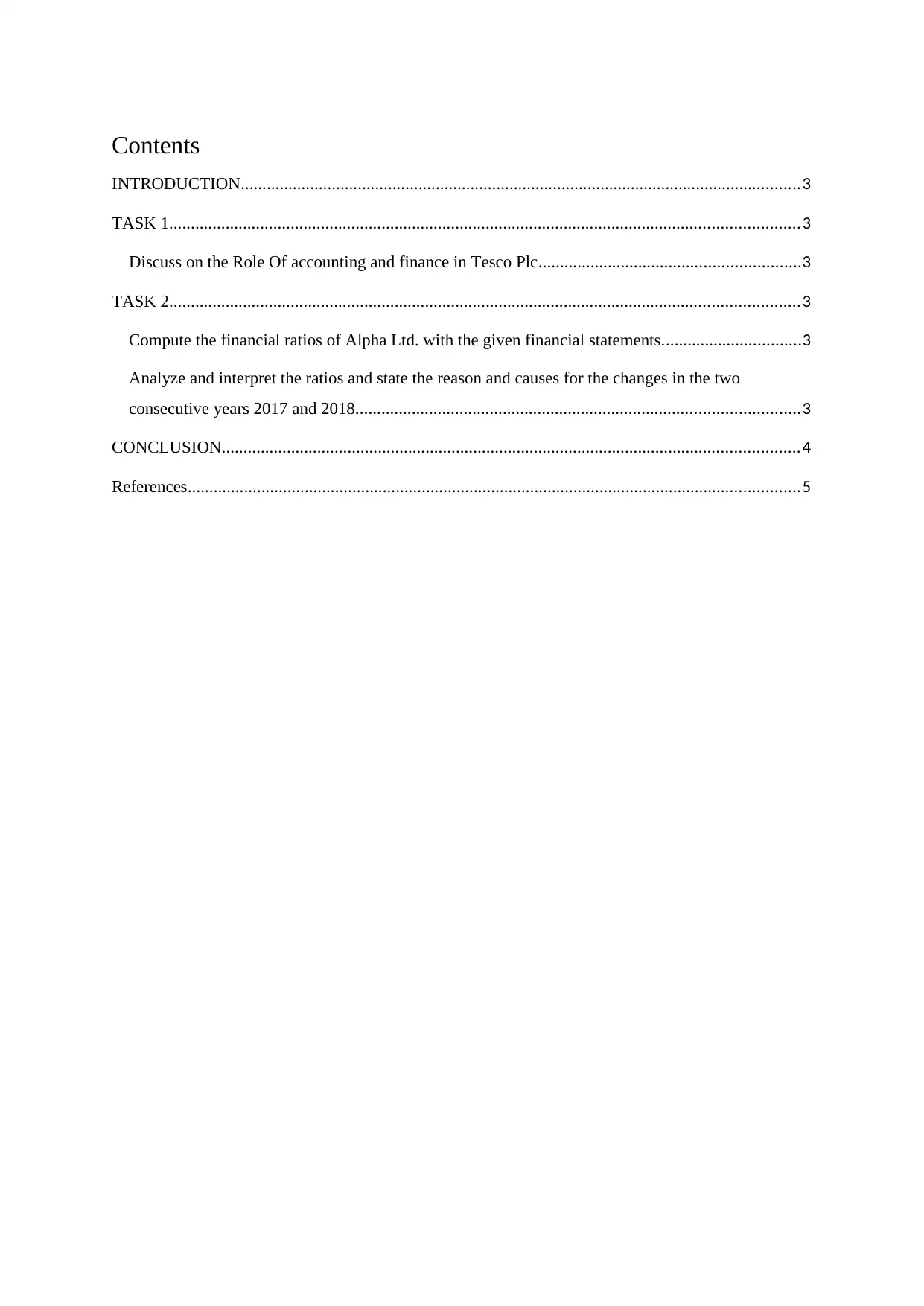
Contents
INTRODUCTION.................................................................................................................................3
TASK 1.................................................................................................................................................3
Discuss on the Role Of accounting and finance in Tesco Plc............................................................3
TASK 2.................................................................................................................................................3
Compute the financial ratios of Alpha Ltd. with the given financial statements................................3
Analyze and interpret the ratios and state the reason and causes for the changes in the two
consecutive years 2017 and 2018......................................................................................................3
CONCLUSION.....................................................................................................................................4
References.............................................................................................................................................5
INTRODUCTION.................................................................................................................................3
TASK 1.................................................................................................................................................3
Discuss on the Role Of accounting and finance in Tesco Plc............................................................3
TASK 2.................................................................................................................................................3
Compute the financial ratios of Alpha Ltd. with the given financial statements................................3
Analyze and interpret the ratios and state the reason and causes for the changes in the two
consecutive years 2017 and 2018......................................................................................................3
CONCLUSION.....................................................................................................................................4
References.............................................................................................................................................5
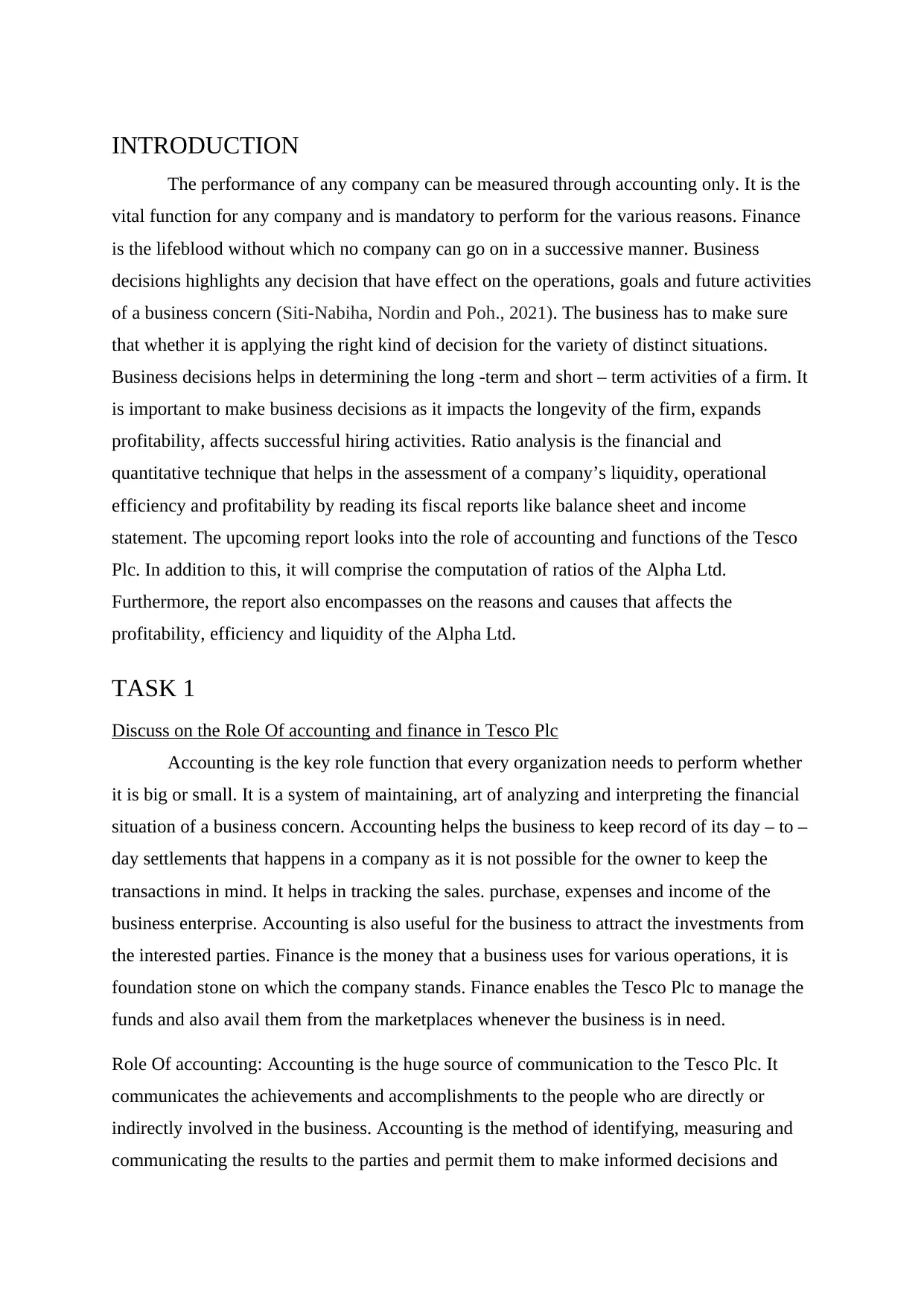
INTRODUCTION
The performance of any company can be measured through accounting only. It is the
vital function for any company and is mandatory to perform for the various reasons. Finance
is the lifeblood without which no company can go on in a successive manner. Business
decisions highlights any decision that have effect on the operations, goals and future activities
of a business concern (Siti-Nabiha, Nordin and Poh., 2021). The business has to make sure
that whether it is applying the right kind of decision for the variety of distinct situations.
Business decisions helps in determining the long -term and short – term activities of a firm. It
is important to make business decisions as it impacts the longevity of the firm, expands
profitability, affects successful hiring activities. Ratio analysis is the financial and
quantitative technique that helps in the assessment of a company’s liquidity, operational
efficiency and profitability by reading its fiscal reports like balance sheet and income
statement. The upcoming report looks into the role of accounting and functions of the Tesco
Plc. In addition to this, it will comprise the computation of ratios of the Alpha Ltd.
Furthermore, the report also encompasses on the reasons and causes that affects the
profitability, efficiency and liquidity of the Alpha Ltd.
TASK 1
Discuss on the Role Of accounting and finance in Tesco Plc
Accounting is the key role function that every organization needs to perform whether
it is big or small. It is a system of maintaining, art of analyzing and interpreting the financial
situation of a business concern. Accounting helps the business to keep record of its day – to –
day settlements that happens in a company as it is not possible for the owner to keep the
transactions in mind. It helps in tracking the sales. purchase, expenses and income of the
business enterprise. Accounting is also useful for the business to attract the investments from
the interested parties. Finance is the money that a business uses for various operations, it is
foundation stone on which the company stands. Finance enables the Tesco Plc to manage the
funds and also avail them from the marketplaces whenever the business is in need.
Role Of accounting: Accounting is the huge source of communication to the Tesco Plc. It
communicates the achievements and accomplishments to the people who are directly or
indirectly involved in the business. Accounting is the method of identifying, measuring and
communicating the results to the parties and permit them to make informed decisions and
The performance of any company can be measured through accounting only. It is the
vital function for any company and is mandatory to perform for the various reasons. Finance
is the lifeblood without which no company can go on in a successive manner. Business
decisions highlights any decision that have effect on the operations, goals and future activities
of a business concern (Siti-Nabiha, Nordin and Poh., 2021). The business has to make sure
that whether it is applying the right kind of decision for the variety of distinct situations.
Business decisions helps in determining the long -term and short – term activities of a firm. It
is important to make business decisions as it impacts the longevity of the firm, expands
profitability, affects successful hiring activities. Ratio analysis is the financial and
quantitative technique that helps in the assessment of a company’s liquidity, operational
efficiency and profitability by reading its fiscal reports like balance sheet and income
statement. The upcoming report looks into the role of accounting and functions of the Tesco
Plc. In addition to this, it will comprise the computation of ratios of the Alpha Ltd.
Furthermore, the report also encompasses on the reasons and causes that affects the
profitability, efficiency and liquidity of the Alpha Ltd.
TASK 1
Discuss on the Role Of accounting and finance in Tesco Plc
Accounting is the key role function that every organization needs to perform whether
it is big or small. It is a system of maintaining, art of analyzing and interpreting the financial
situation of a business concern. Accounting helps the business to keep record of its day – to –
day settlements that happens in a company as it is not possible for the owner to keep the
transactions in mind. It helps in tracking the sales. purchase, expenses and income of the
business enterprise. Accounting is also useful for the business to attract the investments from
the interested parties. Finance is the money that a business uses for various operations, it is
foundation stone on which the company stands. Finance enables the Tesco Plc to manage the
funds and also avail them from the marketplaces whenever the business is in need.
Role Of accounting: Accounting is the huge source of communication to the Tesco Plc. It
communicates the achievements and accomplishments to the people who are directly or
indirectly involved in the business. Accounting is the method of identifying, measuring and
communicating the results to the parties and permit them to make informed decisions and
⊘ This is a preview!⊘
Do you want full access?
Subscribe today to unlock all pages.

Trusted by 1+ million students worldwide
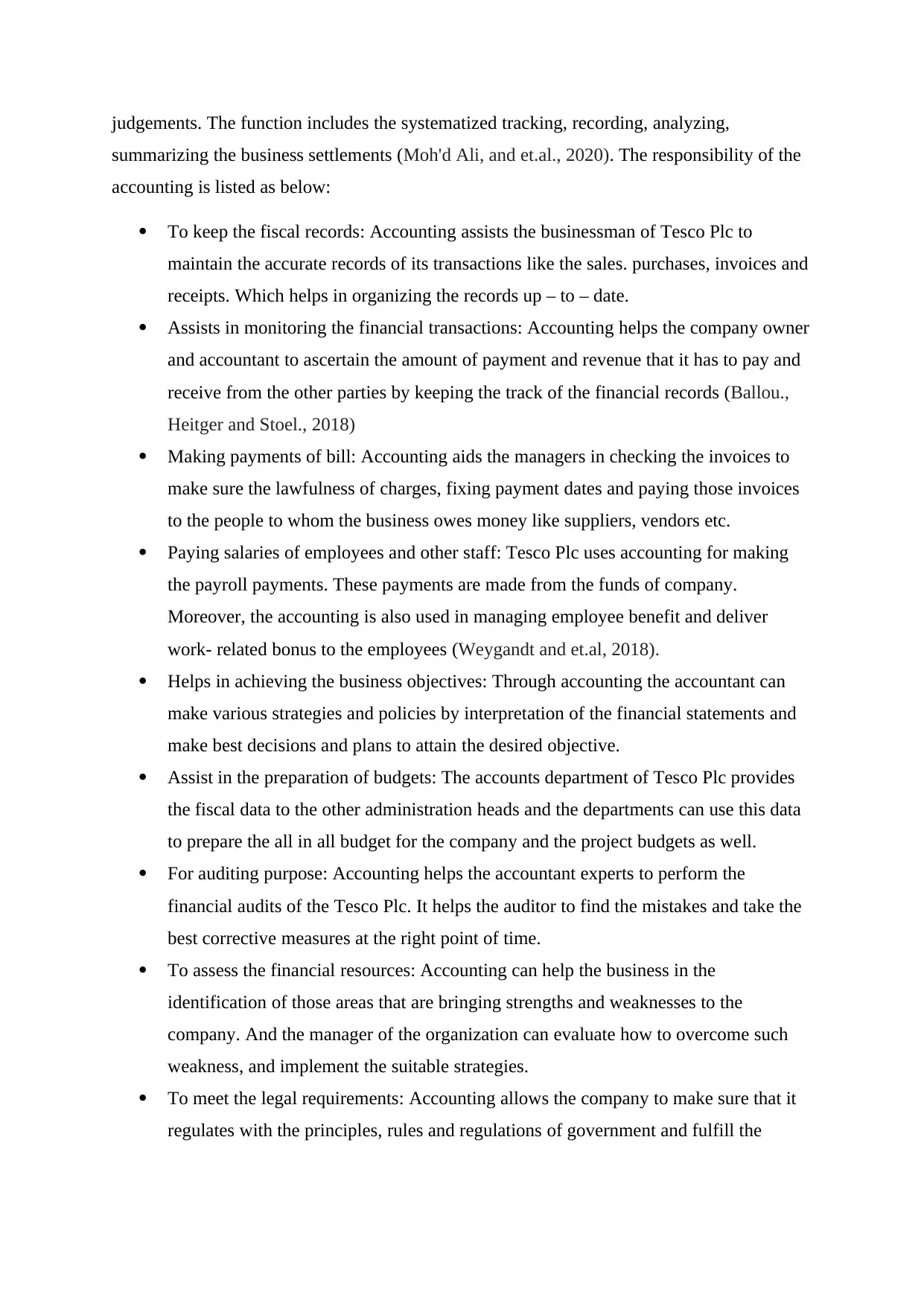
judgements. The function includes the systematized tracking, recording, analyzing,
summarizing the business settlements (Moh'd Ali, and et.al., 2020). The responsibility of the
accounting is listed as below:
To keep the fiscal records: Accounting assists the businessman of Tesco Plc to
maintain the accurate records of its transactions like the sales. purchases, invoices and
receipts. Which helps in organizing the records up – to – date.
Assists in monitoring the financial transactions: Accounting helps the company owner
and accountant to ascertain the amount of payment and revenue that it has to pay and
receive from the other parties by keeping the track of the financial records (Ballou.,
Heitger and Stoel., 2018)
Making payments of bill: Accounting aids the managers in checking the invoices to
make sure the lawfulness of charges, fixing payment dates and paying those invoices
to the people to whom the business owes money like suppliers, vendors etc.
Paying salaries of employees and other staff: Tesco Plc uses accounting for making
the payroll payments. These payments are made from the funds of company.
Moreover, the accounting is also used in managing employee benefit and deliver
work- related bonus to the employees (Weygandt and et.al, 2018).
Helps in achieving the business objectives: Through accounting the accountant can
make various strategies and policies by interpretation of the financial statements and
make best decisions and plans to attain the desired objective.
Assist in the preparation of budgets: The accounts department of Tesco Plc provides
the fiscal data to the other administration heads and the departments can use this data
to prepare the all in all budget for the company and the project budgets as well.
For auditing purpose: Accounting helps the accountant experts to perform the
financial audits of the Tesco Plc. It helps the auditor to find the mistakes and take the
best corrective measures at the right point of time.
To assess the financial resources: Accounting can help the business in the
identification of those areas that are bringing strengths and weaknesses to the
company. And the manager of the organization can evaluate how to overcome such
weakness, and implement the suitable strategies.
To meet the legal requirements: Accounting allows the company to make sure that it
regulates with the principles, rules and regulations of government and fulfill the
summarizing the business settlements (Moh'd Ali, and et.al., 2020). The responsibility of the
accounting is listed as below:
To keep the fiscal records: Accounting assists the businessman of Tesco Plc to
maintain the accurate records of its transactions like the sales. purchases, invoices and
receipts. Which helps in organizing the records up – to – date.
Assists in monitoring the financial transactions: Accounting helps the company owner
and accountant to ascertain the amount of payment and revenue that it has to pay and
receive from the other parties by keeping the track of the financial records (Ballou.,
Heitger and Stoel., 2018)
Making payments of bill: Accounting aids the managers in checking the invoices to
make sure the lawfulness of charges, fixing payment dates and paying those invoices
to the people to whom the business owes money like suppliers, vendors etc.
Paying salaries of employees and other staff: Tesco Plc uses accounting for making
the payroll payments. These payments are made from the funds of company.
Moreover, the accounting is also used in managing employee benefit and deliver
work- related bonus to the employees (Weygandt and et.al, 2018).
Helps in achieving the business objectives: Through accounting the accountant can
make various strategies and policies by interpretation of the financial statements and
make best decisions and plans to attain the desired objective.
Assist in the preparation of budgets: The accounts department of Tesco Plc provides
the fiscal data to the other administration heads and the departments can use this data
to prepare the all in all budget for the company and the project budgets as well.
For auditing purpose: Accounting helps the accountant experts to perform the
financial audits of the Tesco Plc. It helps the auditor to find the mistakes and take the
best corrective measures at the right point of time.
To assess the financial resources: Accounting can help the business in the
identification of those areas that are bringing strengths and weaknesses to the
company. And the manager of the organization can evaluate how to overcome such
weakness, and implement the suitable strategies.
To meet the legal requirements: Accounting allows the company to make sure that it
regulates with the principles, rules and regulations of government and fulfill the
Paraphrase This Document
Need a fresh take? Get an instant paraphrase of this document with our AI Paraphraser
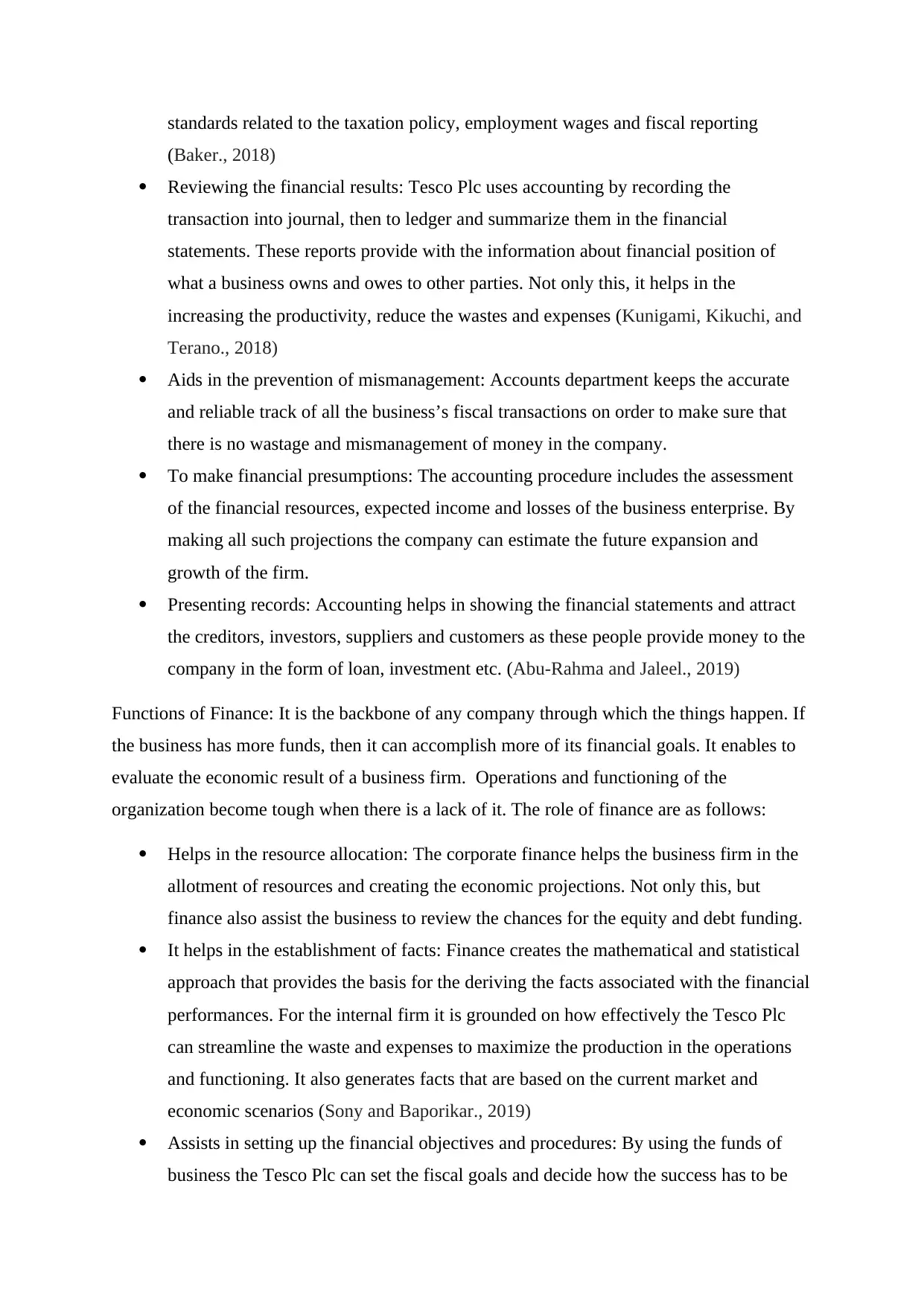
standards related to the taxation policy, employment wages and fiscal reporting
(Baker., 2018)
Reviewing the financial results: Tesco Plc uses accounting by recording the
transaction into journal, then to ledger and summarize them in the financial
statements. These reports provide with the information about financial position of
what a business owns and owes to other parties. Not only this, it helps in the
increasing the productivity, reduce the wastes and expenses (Kunigami, Kikuchi, and
Terano., 2018)
Aids in the prevention of mismanagement: Accounts department keeps the accurate
and reliable track of all the business’s fiscal transactions on order to make sure that
there is no wastage and mismanagement of money in the company.
To make financial presumptions: The accounting procedure includes the assessment
of the financial resources, expected income and losses of the business enterprise. By
making all such projections the company can estimate the future expansion and
growth of the firm.
Presenting records: Accounting helps in showing the financial statements and attract
the creditors, investors, suppliers and customers as these people provide money to the
company in the form of loan, investment etc. (Abu-Rahma and Jaleel., 2019)
Functions of Finance: It is the backbone of any company through which the things happen. If
the business has more funds, then it can accomplish more of its financial goals. It enables to
evaluate the economic result of a business firm. Operations and functioning of the
organization become tough when there is a lack of it. The role of finance are as follows:
Helps in the resource allocation: The corporate finance helps the business firm in the
allotment of resources and creating the economic projections. Not only this, but
finance also assist the business to review the chances for the equity and debt funding.
It helps in the establishment of facts: Finance creates the mathematical and statistical
approach that provides the basis for the deriving the facts associated with the financial
performances. For the internal firm it is grounded on how effectively the Tesco Plc
can streamline the waste and expenses to maximize the production in the operations
and functioning. It also generates facts that are based on the current market and
economic scenarios (Sony and Baporikar., 2019)
Assists in setting up the financial objectives and procedures: By using the funds of
business the Tesco Plc can set the fiscal goals and decide how the success has to be
(Baker., 2018)
Reviewing the financial results: Tesco Plc uses accounting by recording the
transaction into journal, then to ledger and summarize them in the financial
statements. These reports provide with the information about financial position of
what a business owns and owes to other parties. Not only this, it helps in the
increasing the productivity, reduce the wastes and expenses (Kunigami, Kikuchi, and
Terano., 2018)
Aids in the prevention of mismanagement: Accounts department keeps the accurate
and reliable track of all the business’s fiscal transactions on order to make sure that
there is no wastage and mismanagement of money in the company.
To make financial presumptions: The accounting procedure includes the assessment
of the financial resources, expected income and losses of the business enterprise. By
making all such projections the company can estimate the future expansion and
growth of the firm.
Presenting records: Accounting helps in showing the financial statements and attract
the creditors, investors, suppliers and customers as these people provide money to the
company in the form of loan, investment etc. (Abu-Rahma and Jaleel., 2019)
Functions of Finance: It is the backbone of any company through which the things happen. If
the business has more funds, then it can accomplish more of its financial goals. It enables to
evaluate the economic result of a business firm. Operations and functioning of the
organization become tough when there is a lack of it. The role of finance are as follows:
Helps in the resource allocation: The corporate finance helps the business firm in the
allotment of resources and creating the economic projections. Not only this, but
finance also assist the business to review the chances for the equity and debt funding.
It helps in the establishment of facts: Finance creates the mathematical and statistical
approach that provides the basis for the deriving the facts associated with the financial
performances. For the internal firm it is grounded on how effectively the Tesco Plc
can streamline the waste and expenses to maximize the production in the operations
and functioning. It also generates facts that are based on the current market and
economic scenarios (Sony and Baporikar., 2019)
Assists in setting up the financial objectives and procedures: By using the funds of
business the Tesco Plc can set the fiscal goals and decide how the success has to be
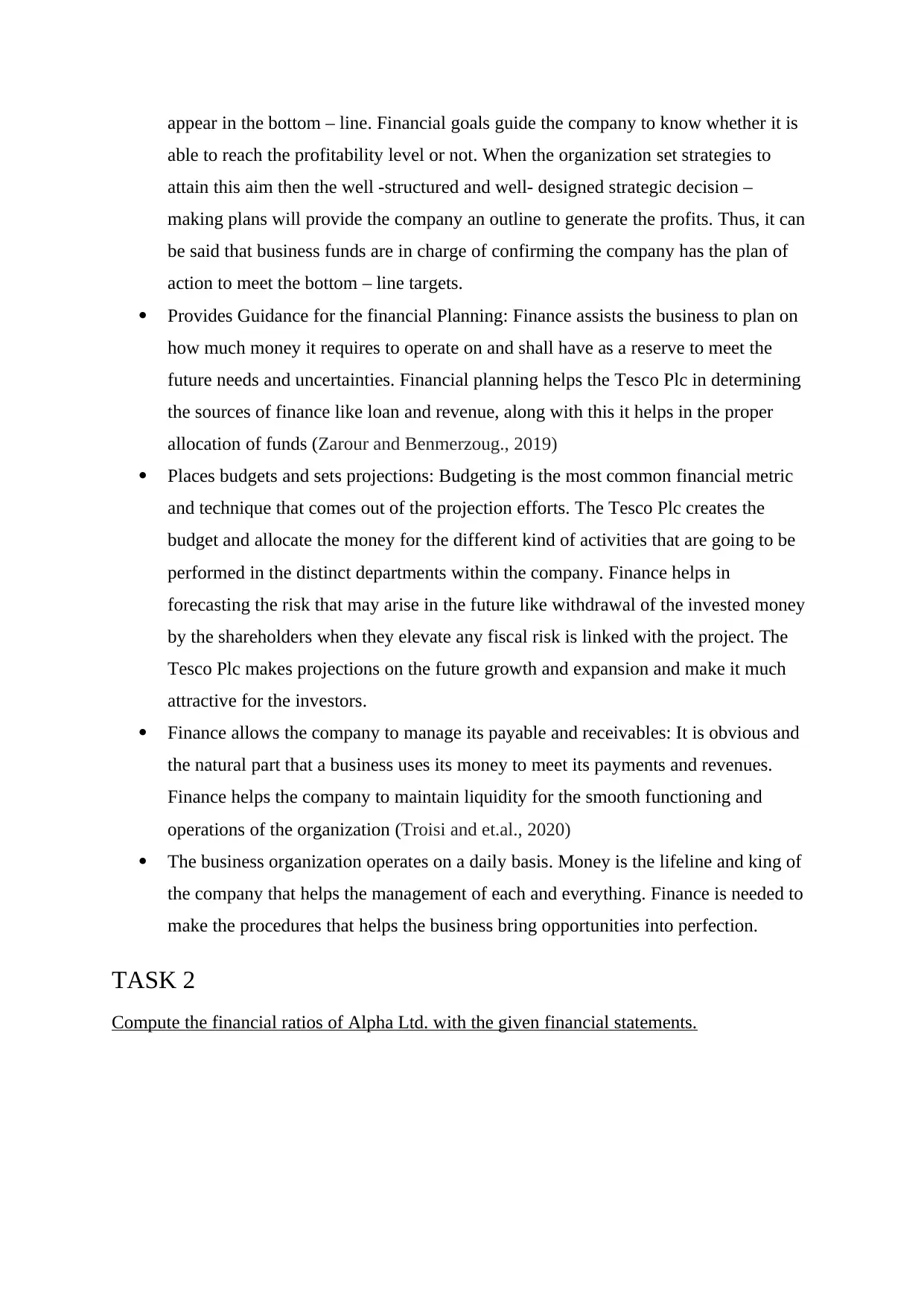
appear in the bottom – line. Financial goals guide the company to know whether it is
able to reach the profitability level or not. When the organization set strategies to
attain this aim then the well -structured and well- designed strategic decision –
making plans will provide the company an outline to generate the profits. Thus, it can
be said that business funds are in charge of confirming the company has the plan of
action to meet the bottom – line targets.
Provides Guidance for the financial Planning: Finance assists the business to plan on
how much money it requires to operate on and shall have as a reserve to meet the
future needs and uncertainties. Financial planning helps the Tesco Plc in determining
the sources of finance like loan and revenue, along with this it helps in the proper
allocation of funds (Zarour and Benmerzoug., 2019)
Places budgets and sets projections: Budgeting is the most common financial metric
and technique that comes out of the projection efforts. The Tesco Plc creates the
budget and allocate the money for the different kind of activities that are going to be
performed in the distinct departments within the company. Finance helps in
forecasting the risk that may arise in the future like withdrawal of the invested money
by the shareholders when they elevate any fiscal risk is linked with the project. The
Tesco Plc makes projections on the future growth and expansion and make it much
attractive for the investors.
Finance allows the company to manage its payable and receivables: It is obvious and
the natural part that a business uses its money to meet its payments and revenues.
Finance helps the company to maintain liquidity for the smooth functioning and
operations of the organization (Troisi and et.al., 2020)
The business organization operates on a daily basis. Money is the lifeline and king of
the company that helps the management of each and everything. Finance is needed to
make the procedures that helps the business bring opportunities into perfection.
TASK 2
Compute the financial ratios of Alpha Ltd. with the given financial statements.
able to reach the profitability level or not. When the organization set strategies to
attain this aim then the well -structured and well- designed strategic decision –
making plans will provide the company an outline to generate the profits. Thus, it can
be said that business funds are in charge of confirming the company has the plan of
action to meet the bottom – line targets.
Provides Guidance for the financial Planning: Finance assists the business to plan on
how much money it requires to operate on and shall have as a reserve to meet the
future needs and uncertainties. Financial planning helps the Tesco Plc in determining
the sources of finance like loan and revenue, along with this it helps in the proper
allocation of funds (Zarour and Benmerzoug., 2019)
Places budgets and sets projections: Budgeting is the most common financial metric
and technique that comes out of the projection efforts. The Tesco Plc creates the
budget and allocate the money for the different kind of activities that are going to be
performed in the distinct departments within the company. Finance helps in
forecasting the risk that may arise in the future like withdrawal of the invested money
by the shareholders when they elevate any fiscal risk is linked with the project. The
Tesco Plc makes projections on the future growth and expansion and make it much
attractive for the investors.
Finance allows the company to manage its payable and receivables: It is obvious and
the natural part that a business uses its money to meet its payments and revenues.
Finance helps the company to maintain liquidity for the smooth functioning and
operations of the organization (Troisi and et.al., 2020)
The business organization operates on a daily basis. Money is the lifeline and king of
the company that helps the management of each and everything. Finance is needed to
make the procedures that helps the business bring opportunities into perfection.
TASK 2
Compute the financial ratios of Alpha Ltd. with the given financial statements.
⊘ This is a preview!⊘
Do you want full access?
Subscribe today to unlock all pages.

Trusted by 1+ million students worldwide
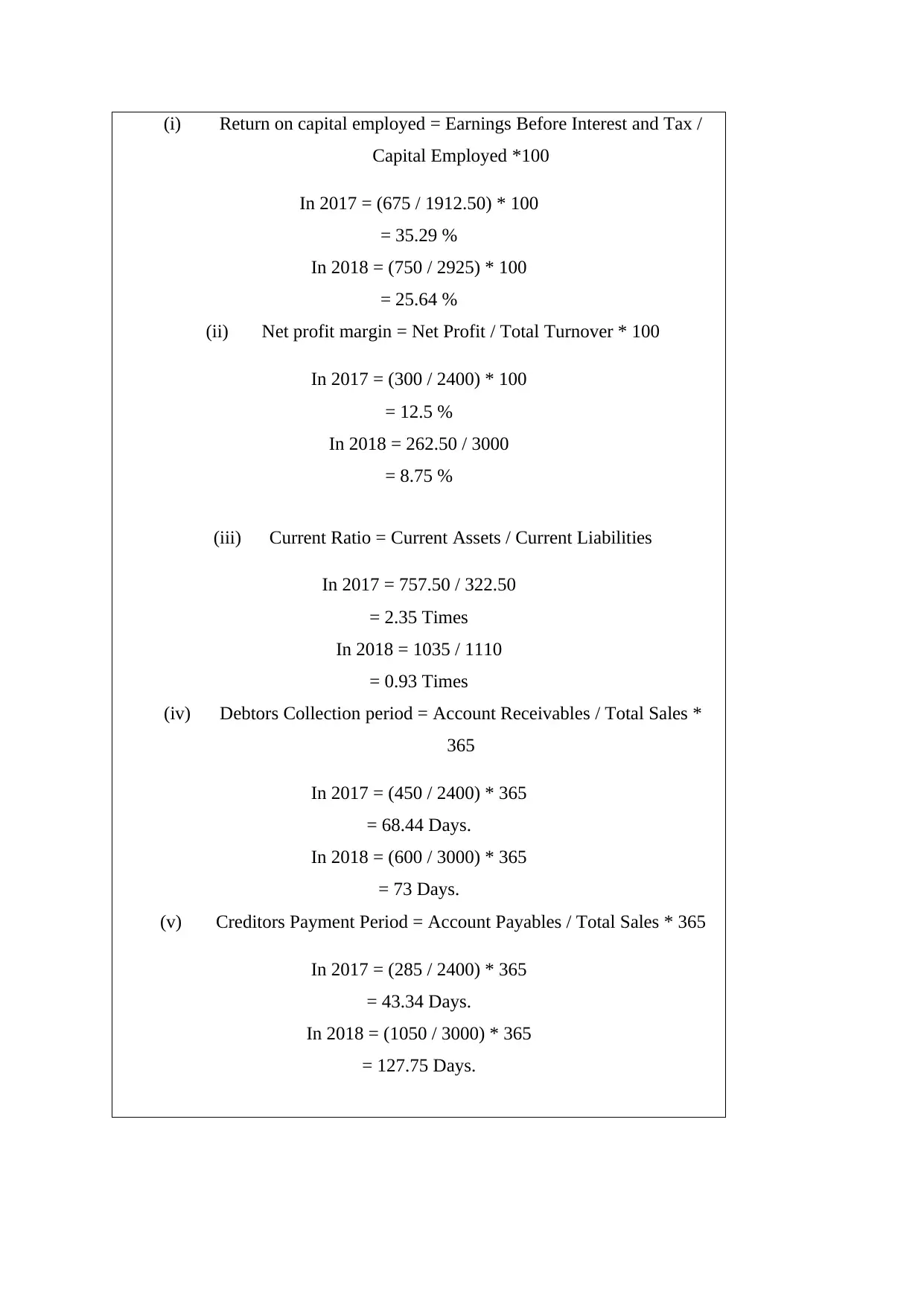
(i) Return on capital employed = Earnings Before Interest and Tax /
Capital Employed *100
In 2017 = (675 / 1912.50) * 100
= 35.29 %
In 2018 = (750 / 2925) * 100
= 25.64 %
(ii) Net profit margin = Net Profit / Total Turnover * 100
In 2017 = (300 / 2400) * 100
= 12.5 %
In 2018 = 262.50 / 3000
= 8.75 %
(iii) Current Ratio = Current Assets / Current Liabilities
In 2017 = 757.50 / 322.50
= 2.35 Times
In 2018 = 1035 / 1110
= 0.93 Times
(iv) Debtors Collection period = Account Receivables / Total Sales *
365
In 2017 = (450 / 2400) * 365
= 68.44 Days.
In 2018 = (600 / 3000) * 365
= 73 Days.
(v) Creditors Payment Period = Account Payables / Total Sales * 365
In 2017 = (285 / 2400) * 365
= 43.34 Days.
In 2018 = (1050 / 3000) * 365
= 127.75 Days.
Capital Employed *100
In 2017 = (675 / 1912.50) * 100
= 35.29 %
In 2018 = (750 / 2925) * 100
= 25.64 %
(ii) Net profit margin = Net Profit / Total Turnover * 100
In 2017 = (300 / 2400) * 100
= 12.5 %
In 2018 = 262.50 / 3000
= 8.75 %
(iii) Current Ratio = Current Assets / Current Liabilities
In 2017 = 757.50 / 322.50
= 2.35 Times
In 2018 = 1035 / 1110
= 0.93 Times
(iv) Debtors Collection period = Account Receivables / Total Sales *
365
In 2017 = (450 / 2400) * 365
= 68.44 Days.
In 2018 = (600 / 3000) * 365
= 73 Days.
(v) Creditors Payment Period = Account Payables / Total Sales * 365
In 2017 = (285 / 2400) * 365
= 43.34 Days.
In 2018 = (1050 / 3000) * 365
= 127.75 Days.
Paraphrase This Document
Need a fresh take? Get an instant paraphrase of this document with our AI Paraphraser
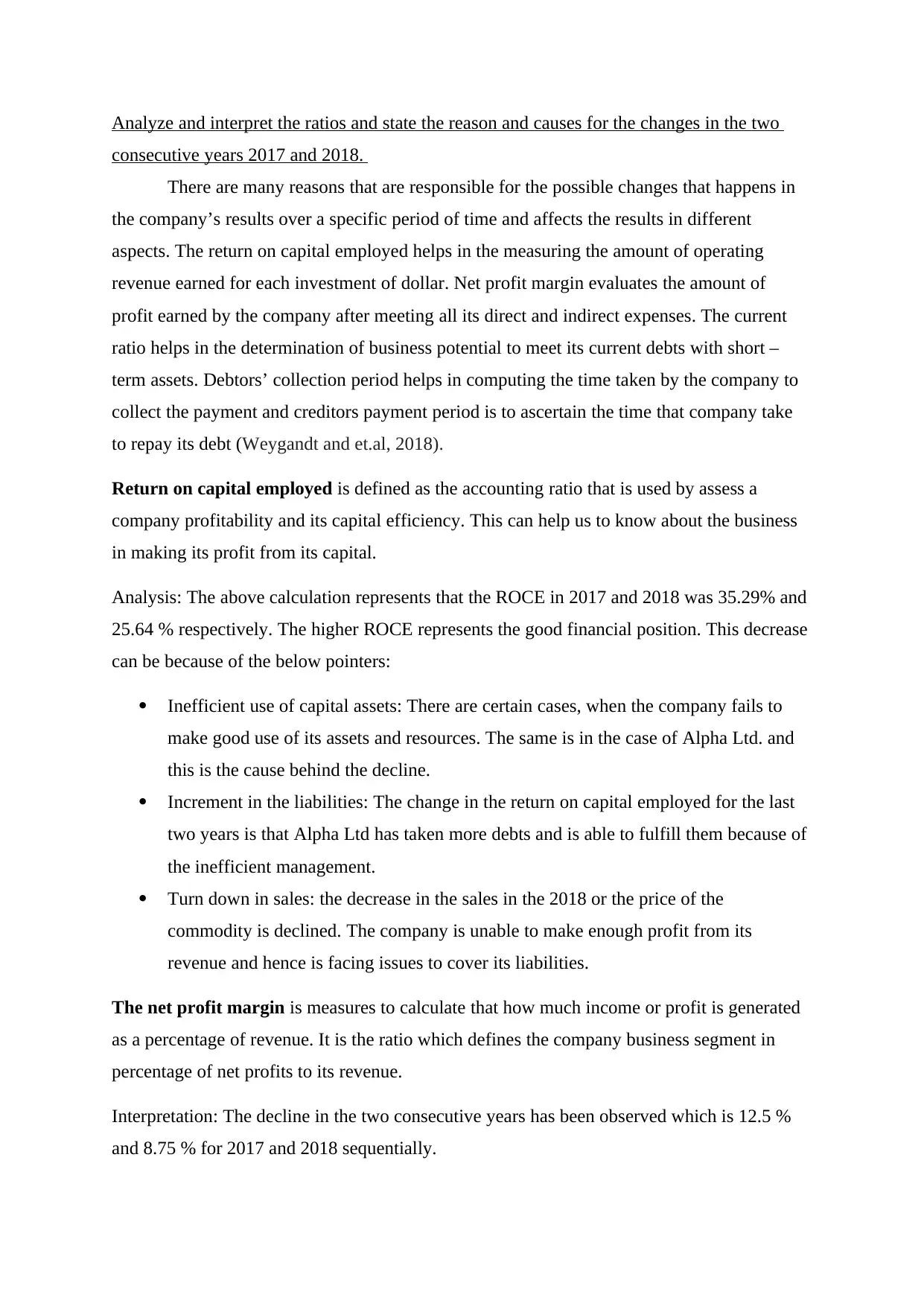
Analyze and interpret the ratios and state the reason and causes for the changes in the two
consecutive years 2017 and 2018.
There are many reasons that are responsible for the possible changes that happens in
the company’s results over a specific period of time and affects the results in different
aspects. The return on capital employed helps in the measuring the amount of operating
revenue earned for each investment of dollar. Net profit margin evaluates the amount of
profit earned by the company after meeting all its direct and indirect expenses. The current
ratio helps in the determination of business potential to meet its current debts with short –
term assets. Debtors’ collection period helps in computing the time taken by the company to
collect the payment and creditors payment period is to ascertain the time that company take
to repay its debt (Weygandt and et.al, 2018).
Return on capital employed is defined as the accounting ratio that is used by assess a
company profitability and its capital efficiency. This can help us to know about the business
in making its profit from its capital.
Analysis: The above calculation represents that the ROCE in 2017 and 2018 was 35.29% and
25.64 % respectively. The higher ROCE represents the good financial position. This decrease
can be because of the below pointers:
Inefficient use of capital assets: There are certain cases, when the company fails to
make good use of its assets and resources. The same is in the case of Alpha Ltd. and
this is the cause behind the decline.
Increment in the liabilities: The change in the return on capital employed for the last
two years is that Alpha Ltd has taken more debts and is able to fulfill them because of
the inefficient management.
Turn down in sales: the decrease in the sales in the 2018 or the price of the
commodity is declined. The company is unable to make enough profit from its
revenue and hence is facing issues to cover its liabilities.
The net profit margin is measures to calculate that how much income or profit is generated
as a percentage of revenue. It is the ratio which defines the company business segment in
percentage of net profits to its revenue.
Interpretation: The decline in the two consecutive years has been observed which is 12.5 %
and 8.75 % for 2017 and 2018 sequentially.
consecutive years 2017 and 2018.
There are many reasons that are responsible for the possible changes that happens in
the company’s results over a specific period of time and affects the results in different
aspects. The return on capital employed helps in the measuring the amount of operating
revenue earned for each investment of dollar. Net profit margin evaluates the amount of
profit earned by the company after meeting all its direct and indirect expenses. The current
ratio helps in the determination of business potential to meet its current debts with short –
term assets. Debtors’ collection period helps in computing the time taken by the company to
collect the payment and creditors payment period is to ascertain the time that company take
to repay its debt (Weygandt and et.al, 2018).
Return on capital employed is defined as the accounting ratio that is used by assess a
company profitability and its capital efficiency. This can help us to know about the business
in making its profit from its capital.
Analysis: The above calculation represents that the ROCE in 2017 and 2018 was 35.29% and
25.64 % respectively. The higher ROCE represents the good financial position. This decrease
can be because of the below pointers:
Inefficient use of capital assets: There are certain cases, when the company fails to
make good use of its assets and resources. The same is in the case of Alpha Ltd. and
this is the cause behind the decline.
Increment in the liabilities: The change in the return on capital employed for the last
two years is that Alpha Ltd has taken more debts and is able to fulfill them because of
the inefficient management.
Turn down in sales: the decrease in the sales in the 2018 or the price of the
commodity is declined. The company is unable to make enough profit from its
revenue and hence is facing issues to cover its liabilities.
The net profit margin is measures to calculate that how much income or profit is generated
as a percentage of revenue. It is the ratio which defines the company business segment in
percentage of net profits to its revenue.
Interpretation: The decline in the two consecutive years has been observed which is 12.5 %
and 8.75 % for 2017 and 2018 sequentially.
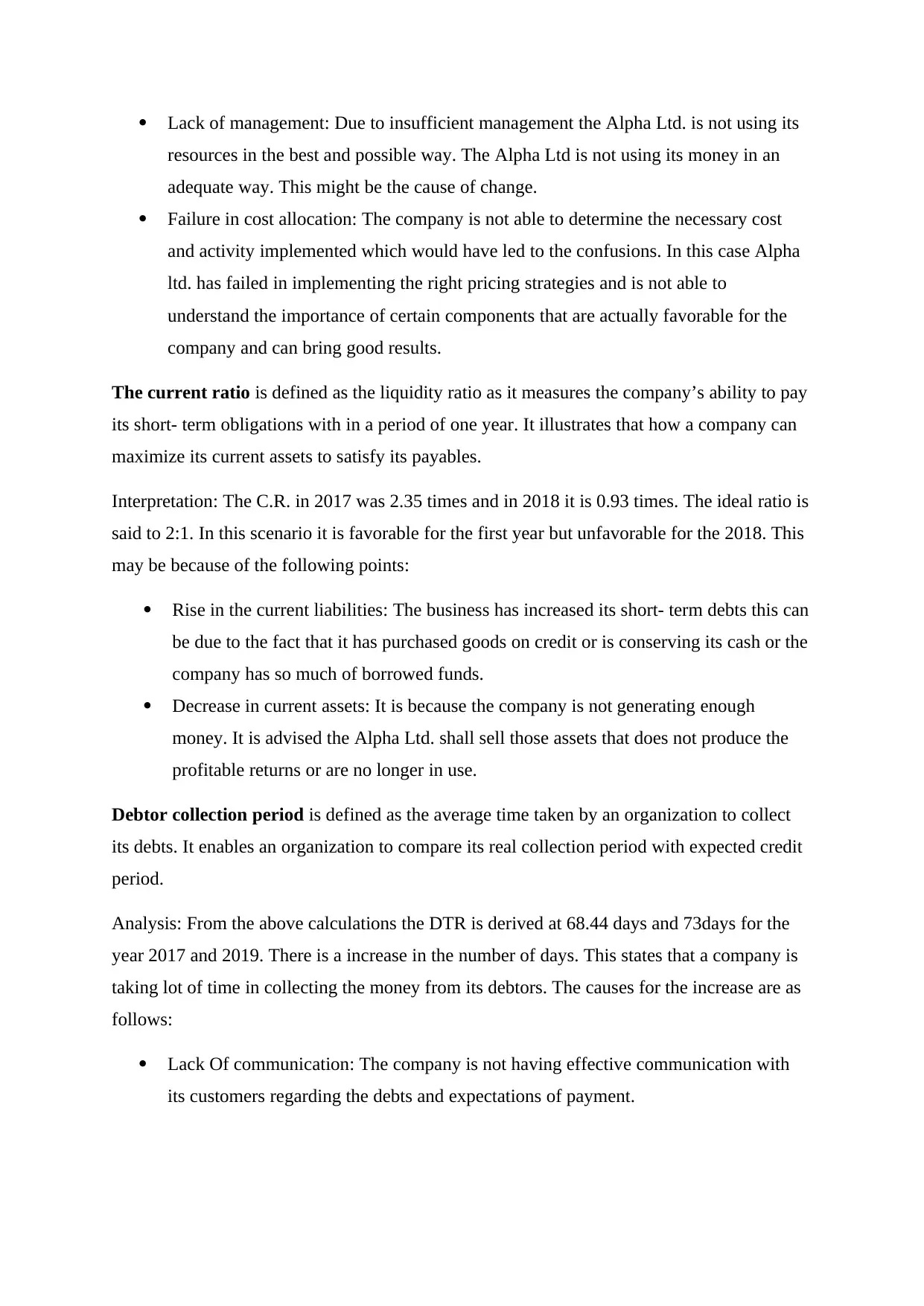
Lack of management: Due to insufficient management the Alpha Ltd. is not using its
resources in the best and possible way. The Alpha Ltd is not using its money in an
adequate way. This might be the cause of change.
Failure in cost allocation: The company is not able to determine the necessary cost
and activity implemented which would have led to the confusions. In this case Alpha
ltd. has failed in implementing the right pricing strategies and is not able to
understand the importance of certain components that are actually favorable for the
company and can bring good results.
The current ratio is defined as the liquidity ratio as it measures the company’s ability to pay
its short- term obligations with in a period of one year. It illustrates that how a company can
maximize its current assets to satisfy its payables.
Interpretation: The C.R. in 2017 was 2.35 times and in 2018 it is 0.93 times. The ideal ratio is
said to 2:1. In this scenario it is favorable for the first year but unfavorable for the 2018. This
may be because of the following points:
Rise in the current liabilities: The business has increased its short- term debts this can
be due to the fact that it has purchased goods on credit or is conserving its cash or the
company has so much of borrowed funds.
Decrease in current assets: It is because the company is not generating enough
money. It is advised the Alpha Ltd. shall sell those assets that does not produce the
profitable returns or are no longer in use.
Debtor collection period is defined as the average time taken by an organization to collect
its debts. It enables an organization to compare its real collection period with expected credit
period.
Analysis: From the above calculations the DTR is derived at 68.44 days and 73days for the
year 2017 and 2019. There is a increase in the number of days. This states that a company is
taking lot of time in collecting the money from its debtors. The causes for the increase are as
follows:
Lack Of communication: The company is not having effective communication with
its customers regarding the debts and expectations of payment.
resources in the best and possible way. The Alpha Ltd is not using its money in an
adequate way. This might be the cause of change.
Failure in cost allocation: The company is not able to determine the necessary cost
and activity implemented which would have led to the confusions. In this case Alpha
ltd. has failed in implementing the right pricing strategies and is not able to
understand the importance of certain components that are actually favorable for the
company and can bring good results.
The current ratio is defined as the liquidity ratio as it measures the company’s ability to pay
its short- term obligations with in a period of one year. It illustrates that how a company can
maximize its current assets to satisfy its payables.
Interpretation: The C.R. in 2017 was 2.35 times and in 2018 it is 0.93 times. The ideal ratio is
said to 2:1. In this scenario it is favorable for the first year but unfavorable for the 2018. This
may be because of the following points:
Rise in the current liabilities: The business has increased its short- term debts this can
be due to the fact that it has purchased goods on credit or is conserving its cash or the
company has so much of borrowed funds.
Decrease in current assets: It is because the company is not generating enough
money. It is advised the Alpha Ltd. shall sell those assets that does not produce the
profitable returns or are no longer in use.
Debtor collection period is defined as the average time taken by an organization to collect
its debts. It enables an organization to compare its real collection period with expected credit
period.
Analysis: From the above calculations the DTR is derived at 68.44 days and 73days for the
year 2017 and 2019. There is a increase in the number of days. This states that a company is
taking lot of time in collecting the money from its debtors. The causes for the increase are as
follows:
Lack Of communication: The company is not having effective communication with
its customers regarding the debts and expectations of payment.
⊘ This is a preview!⊘
Do you want full access?
Subscribe today to unlock all pages.

Trusted by 1+ million students worldwide
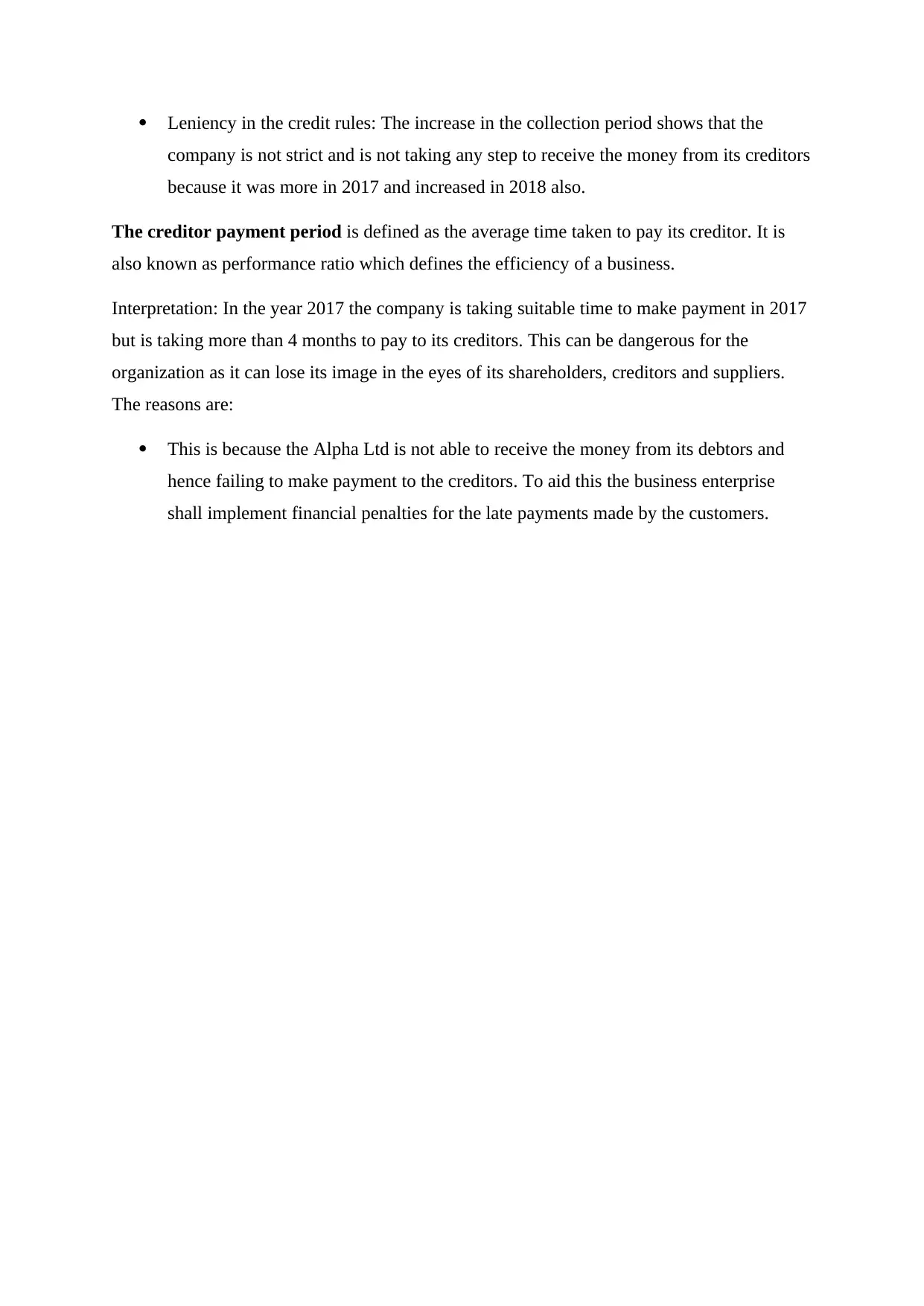
Leniency in the credit rules: The increase in the collection period shows that the
company is not strict and is not taking any step to receive the money from its creditors
because it was more in 2017 and increased in 2018 also.
The creditor payment period is defined as the average time taken to pay its creditor. It is
also known as performance ratio which defines the efficiency of a business.
Interpretation: In the year 2017 the company is taking suitable time to make payment in 2017
but is taking more than 4 months to pay to its creditors. This can be dangerous for the
organization as it can lose its image in the eyes of its shareholders, creditors and suppliers.
The reasons are:
This is because the Alpha Ltd is not able to receive the money from its debtors and
hence failing to make payment to the creditors. To aid this the business enterprise
shall implement financial penalties for the late payments made by the customers.
company is not strict and is not taking any step to receive the money from its creditors
because it was more in 2017 and increased in 2018 also.
The creditor payment period is defined as the average time taken to pay its creditor. It is
also known as performance ratio which defines the efficiency of a business.
Interpretation: In the year 2017 the company is taking suitable time to make payment in 2017
but is taking more than 4 months to pay to its creditors. This can be dangerous for the
organization as it can lose its image in the eyes of its shareholders, creditors and suppliers.
The reasons are:
This is because the Alpha Ltd is not able to receive the money from its debtors and
hence failing to make payment to the creditors. To aid this the business enterprise
shall implement financial penalties for the late payments made by the customers.
Paraphrase This Document
Need a fresh take? Get an instant paraphrase of this document with our AI Paraphraser
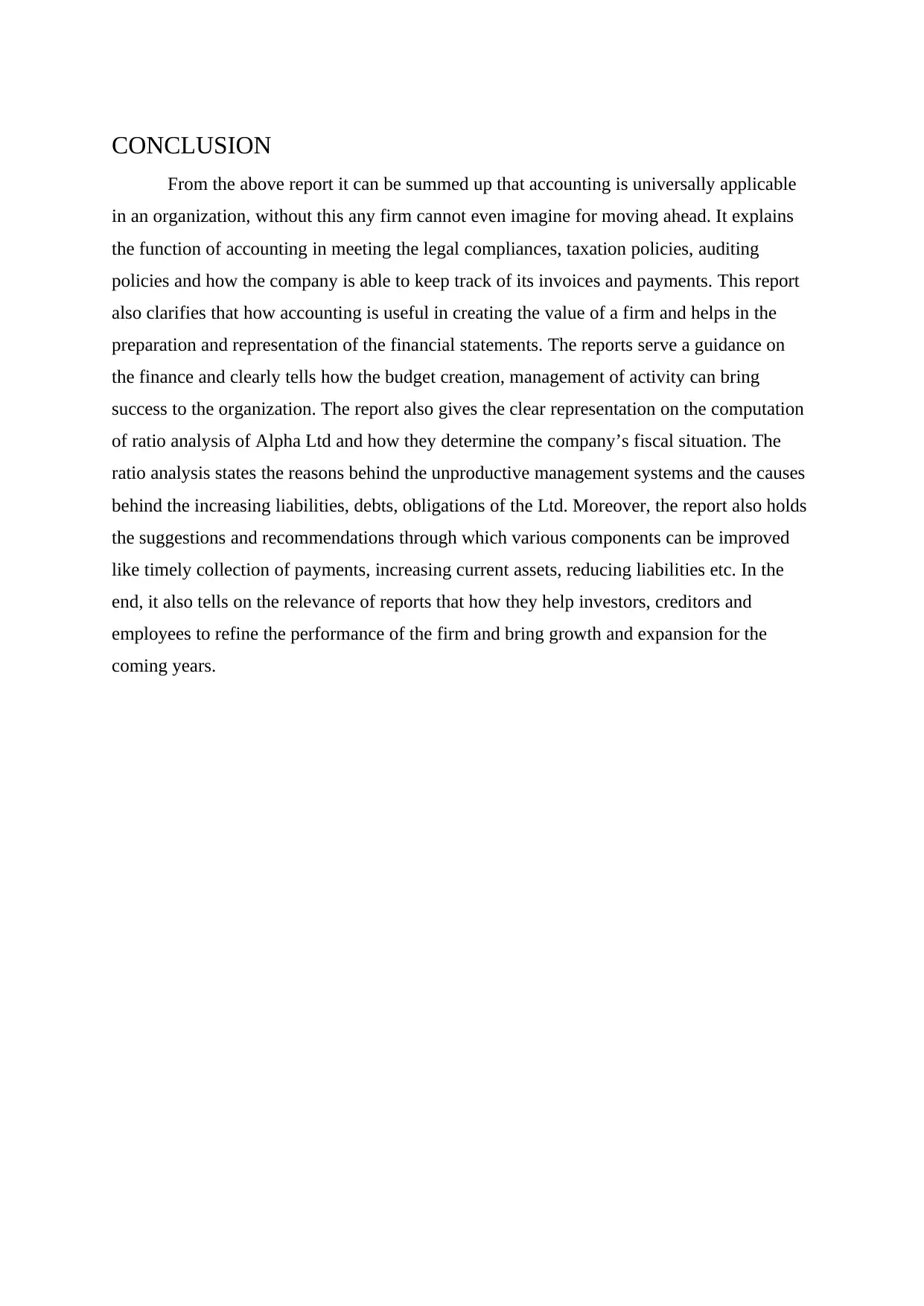
CONCLUSION
From the above report it can be summed up that accounting is universally applicable
in an organization, without this any firm cannot even imagine for moving ahead. It explains
the function of accounting in meeting the legal compliances, taxation policies, auditing
policies and how the company is able to keep track of its invoices and payments. This report
also clarifies that how accounting is useful in creating the value of a firm and helps in the
preparation and representation of the financial statements. The reports serve a guidance on
the finance and clearly tells how the budget creation, management of activity can bring
success to the organization. The report also gives the clear representation on the computation
of ratio analysis of Alpha Ltd and how they determine the company’s fiscal situation. The
ratio analysis states the reasons behind the unproductive management systems and the causes
behind the increasing liabilities, debts, obligations of the Ltd. Moreover, the report also holds
the suggestions and recommendations through which various components can be improved
like timely collection of payments, increasing current assets, reducing liabilities etc. In the
end, it also tells on the relevance of reports that how they help investors, creditors and
employees to refine the performance of the firm and bring growth and expansion for the
coming years.
From the above report it can be summed up that accounting is universally applicable
in an organization, without this any firm cannot even imagine for moving ahead. It explains
the function of accounting in meeting the legal compliances, taxation policies, auditing
policies and how the company is able to keep track of its invoices and payments. This report
also clarifies that how accounting is useful in creating the value of a firm and helps in the
preparation and representation of the financial statements. The reports serve a guidance on
the finance and clearly tells how the budget creation, management of activity can bring
success to the organization. The report also gives the clear representation on the computation
of ratio analysis of Alpha Ltd and how they determine the company’s fiscal situation. The
ratio analysis states the reasons behind the unproductive management systems and the causes
behind the increasing liabilities, debts, obligations of the Ltd. Moreover, the report also holds
the suggestions and recommendations through which various components can be improved
like timely collection of payments, increasing current assets, reducing liabilities etc. In the
end, it also tells on the relevance of reports that how they help investors, creditors and
employees to refine the performance of the firm and bring growth and expansion for the
coming years.
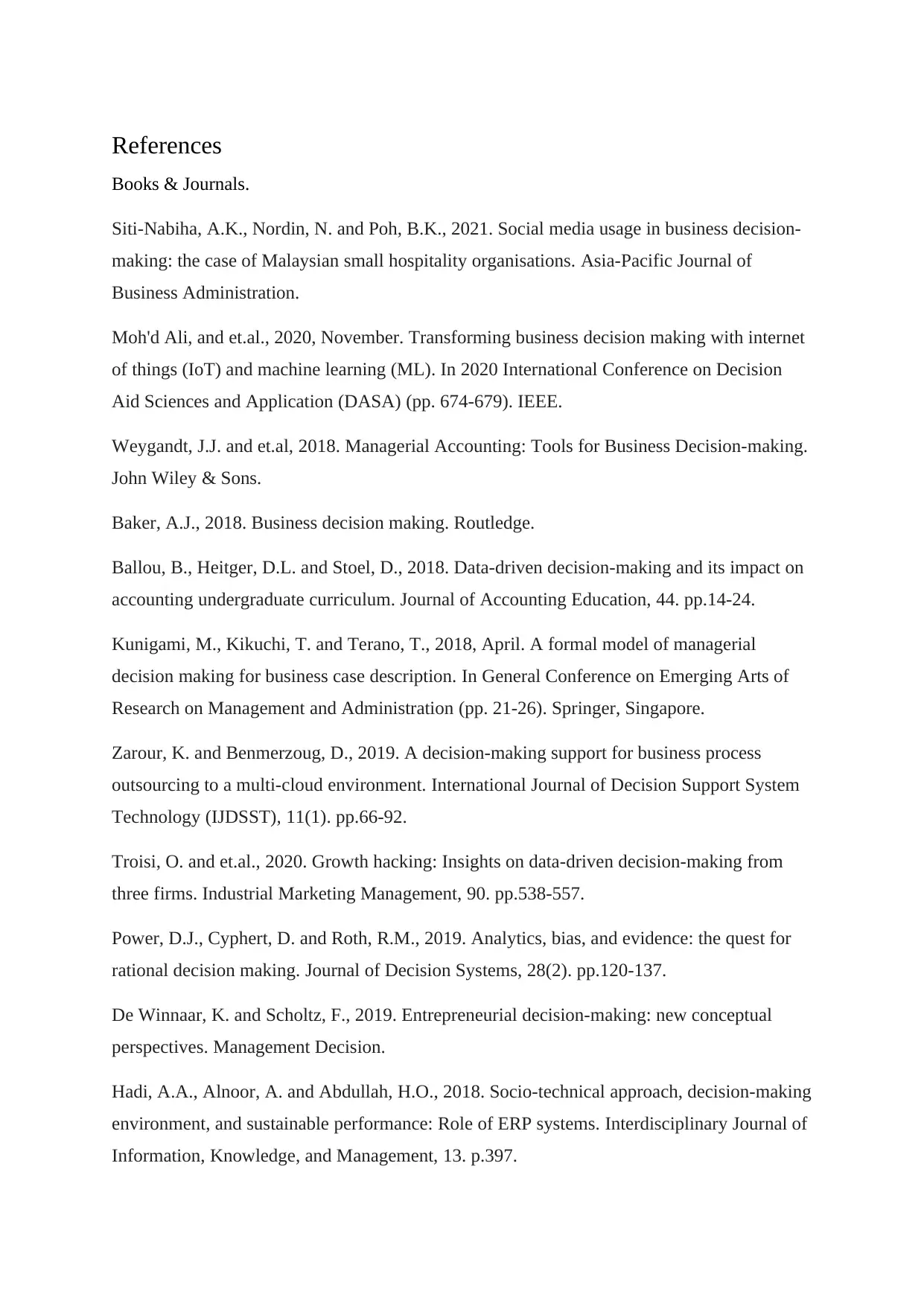
References
Books & Journals.
Siti-Nabiha, A.K., Nordin, N. and Poh, B.K., 2021. Social media usage in business decision-
making: the case of Malaysian small hospitality organisations. Asia-Pacific Journal of
Business Administration.
Moh'd Ali, and et.al., 2020, November. Transforming business decision making with internet
of things (IoT) and machine learning (ML). In 2020 International Conference on Decision
Aid Sciences and Application (DASA) (pp. 674-679). IEEE.
Weygandt, J.J. and et.al, 2018. Managerial Accounting: Tools for Business Decision-making.
John Wiley & Sons.
Baker, A.J., 2018. Business decision making. Routledge.
Ballou, B., Heitger, D.L. and Stoel, D., 2018. Data-driven decision-making and its impact on
accounting undergraduate curriculum. Journal of Accounting Education, 44. pp.14-24.
Kunigami, M., Kikuchi, T. and Terano, T., 2018, April. A formal model of managerial
decision making for business case description. In General Conference on Emerging Arts of
Research on Management and Administration (pp. 21-26). Springer, Singapore.
Zarour, K. and Benmerzoug, D., 2019. A decision-making support for business process
outsourcing to a multi-cloud environment. International Journal of Decision Support System
Technology (IJDSST), 11(1). pp.66-92.
Troisi, O. and et.al., 2020. Growth hacking: Insights on data-driven decision-making from
three firms. Industrial Marketing Management, 90. pp.538-557.
Power, D.J., Cyphert, D. and Roth, R.M., 2019. Analytics, bias, and evidence: the quest for
rational decision making. Journal of Decision Systems, 28(2). pp.120-137.
De Winnaar, K. and Scholtz, F., 2019. Entrepreneurial decision-making: new conceptual
perspectives. Management Decision.
Hadi, A.A., Alnoor, A. and Abdullah, H.O., 2018. Socio-technical approach, decision-making
environment, and sustainable performance: Role of ERP systems. Interdisciplinary Journal of
Information, Knowledge, and Management, 13. p.397.
Books & Journals.
Siti-Nabiha, A.K., Nordin, N. and Poh, B.K., 2021. Social media usage in business decision-
making: the case of Malaysian small hospitality organisations. Asia-Pacific Journal of
Business Administration.
Moh'd Ali, and et.al., 2020, November. Transforming business decision making with internet
of things (IoT) and machine learning (ML). In 2020 International Conference on Decision
Aid Sciences and Application (DASA) (pp. 674-679). IEEE.
Weygandt, J.J. and et.al, 2018. Managerial Accounting: Tools for Business Decision-making.
John Wiley & Sons.
Baker, A.J., 2018. Business decision making. Routledge.
Ballou, B., Heitger, D.L. and Stoel, D., 2018. Data-driven decision-making and its impact on
accounting undergraduate curriculum. Journal of Accounting Education, 44. pp.14-24.
Kunigami, M., Kikuchi, T. and Terano, T., 2018, April. A formal model of managerial
decision making for business case description. In General Conference on Emerging Arts of
Research on Management and Administration (pp. 21-26). Springer, Singapore.
Zarour, K. and Benmerzoug, D., 2019. A decision-making support for business process
outsourcing to a multi-cloud environment. International Journal of Decision Support System
Technology (IJDSST), 11(1). pp.66-92.
Troisi, O. and et.al., 2020. Growth hacking: Insights on data-driven decision-making from
three firms. Industrial Marketing Management, 90. pp.538-557.
Power, D.J., Cyphert, D. and Roth, R.M., 2019. Analytics, bias, and evidence: the quest for
rational decision making. Journal of Decision Systems, 28(2). pp.120-137.
De Winnaar, K. and Scholtz, F., 2019. Entrepreneurial decision-making: new conceptual
perspectives. Management Decision.
Hadi, A.A., Alnoor, A. and Abdullah, H.O., 2018. Socio-technical approach, decision-making
environment, and sustainable performance: Role of ERP systems. Interdisciplinary Journal of
Information, Knowledge, and Management, 13. p.397.
⊘ This is a preview!⊘
Do you want full access?
Subscribe today to unlock all pages.

Trusted by 1+ million students worldwide
1 out of 13
Related Documents
Your All-in-One AI-Powered Toolkit for Academic Success.
+13062052269
info@desklib.com
Available 24*7 on WhatsApp / Email
![[object Object]](/_next/static/media/star-bottom.7253800d.svg)
Unlock your academic potential
Copyright © 2020–2025 A2Z Services. All Rights Reserved. Developed and managed by ZUCOL.





